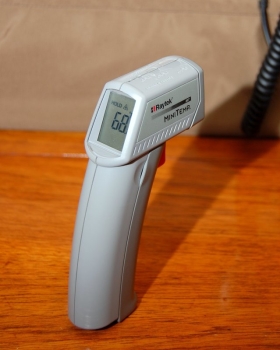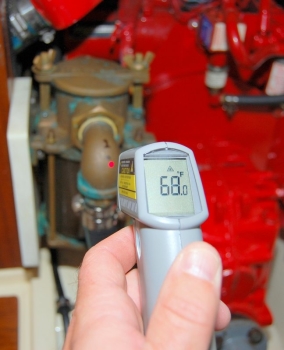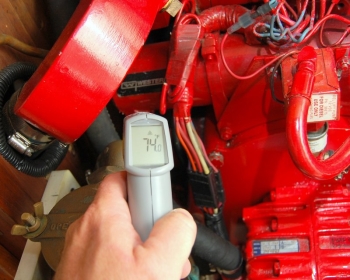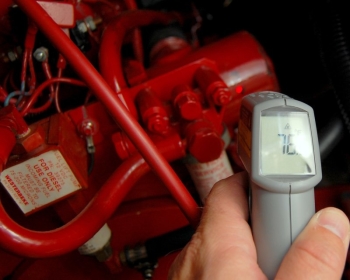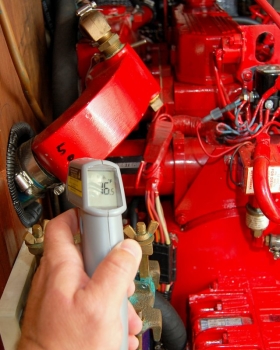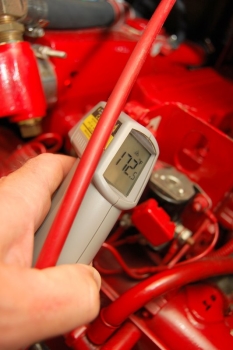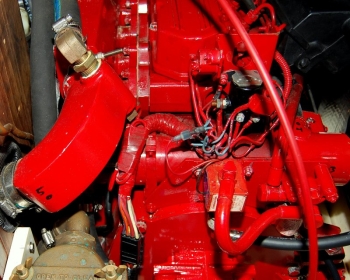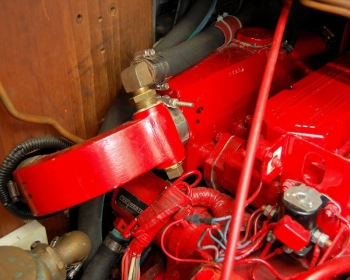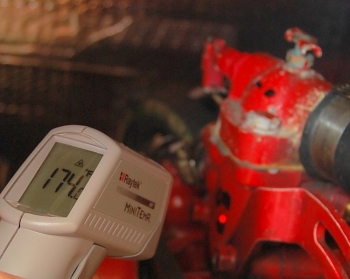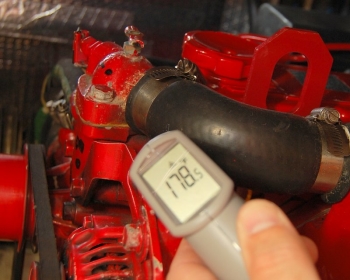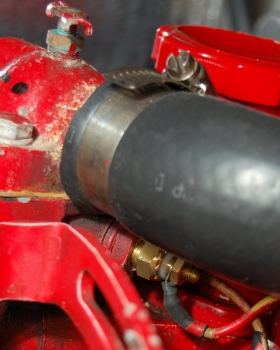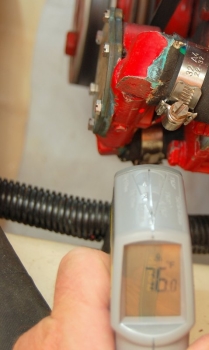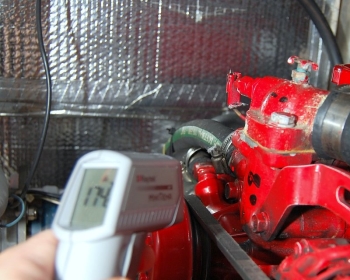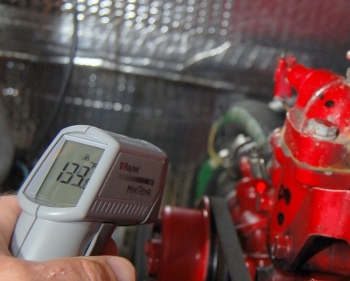An Infrared Thermometer
This is an infrared thermometer and it is what I consider to be an important tool for any boat owner. As I always say “tools are free“. What I mean by this is the expense of the tool, and doing the job yourself, is almost always paid for by the labor savings. In 35 years of tool buying I have yet to find one that was not paid off in one or two projects or uses. Lucky for the average boat owner infrared thermometers, also called pyrometers, have come way down in price over the last 4-5 years.
There are lots of things an infrared thermometer can be used for on a boat such as refrigeration trouble shooting, stuffing box trouble shooting, electrical trouble shooting and it has plenty of uses for engine trouble shooting. You can also aim it at the ocean, before jumping in, to avoid the “I was in the pool.” / shrinkage argument.
What is engine temp monitoring and why am I reading this?
I wanted to pass along my process and pre-planning assessment for potential future overheating events. By following these procedures you will be able to trouble shoot over heating in your own engine based on the baselines you create before a problem arises.
This measurement process should take place well before you’ve had an overheating situation and is the whole premise of this article. It’s to get a baseline when your engine is running well.
You’ll use the infrared thermometer to measure various marked locations on the engine prior to an overheat so that when you have one you can pull out your notebook, tablet or computer, compare measurements, and more quickly isolate and locate the problem.
We’ll call this our engine temp baseline;
Your engine temp baseline should always be derived from a properly running engine with a clean sea-strainer, clean heat exchanger (HX), clean unclogged exhaust elbow and a new or relatively new impeller. Measurements should only be taken after the engine is 100% warmed up from having been run under load long enough to bring the water heater temp as high as the engine normally gets under cruising load.
Measuring the Raw Water Intake Temp
Here I’m measuring the temperature of the elbow leading to the sea strainer. It tells me the Atlantic Ocean under the boat is 68 degrees and that means the temp my raw water pump sees is also 68 degrees.
Take this reading and save it to a Word doc. or just write it in a notebook. This is not a critical reading but nice to know each time you check. If the water temp was 32f then I would not expect the same temps elsewhere on the engine but if it’s within 5-8 degrees all your other readings should fall in line.
Every spot I measure on an engine gets a corresponding number and a dot made with a Sharpie marker. I use the dot so I can get repeatability whenever I aim the thermometer.
Please try to use roughly the same aiming distance when taking measurements. Consistency with an infrared thermometer will lead to more accurate readings. If you used a 6″ distance when creating the baseline stick with a 6″ distance in the future.
Heat Exchanger Raw Water Outlet to Transmission Cooler
Here I’m reading the temp of the raw water circuit on it’s way out of the HX.
The raw water path on this Westerbeke engine is as follows;
- Raw Water Seacock To Sea Strainer
- Sea Strainer to Raw Water Pump
- Raw Water Pump to Heat Exchanger Intake,
- Heat Exchanger Outlet to Transmission Cooler Inlet
- Transmission Cooler Outlet to Siphon Break,
- Siphon Break to Exhaust Elbow.
Please IGNORE the temp readings on my Raytek Infrared as I did not have the time to properly warm up my engine. They are illustrative only! I already had these numbers recorded and merely wanted to photograph how to get your engine temp baseline.
Measuring the raw water temp at the end of the HX
In this photo I’m measuring the temp in the cavity at the opposite end of the HX where the zinc goes. This is a raw water temp measurement.
Measuring The Wet Side of the Exhaust Elbow
This is the exhaust elbow. The exhaust elbow serves the purpose of injecting cooling water into the hot exhaust gasses so they can be expelled through the rubber hoses, inside your boat, without melting them.
In this photo you can easily see my numbering system and the dot for repeatability.
The brass elbow coming into the top side of the exhaust elbow is the injection point for the raw water (ocean or lake water) circuit. This is where the water that gets spit out your transom gets injected into the exhaust system to keep it cool.
This temp, and the next one, are very critical measurements. Exhaust elbows, on short run time sailboat installed diesels, tend to load up with rust scale and carbon until they become blocked or clogged. A blockage of the exhaust elbow can definitely cause an over heating event.
Measuring the Dry Side of the Exhaust Manifold
On this Westerbeke, and most other diesel engines, the exhaust injection elbow is bolted or welded directly to the exhaust manifold. This measurement is to measure how hot the actual dry exhaust gasses are before they are mixed with raw cooling water..
As you can see there is about a 100 degree drop in exhaust gas temp after the water injection point. This reading is a little low for this engine but again this was for illustrative purposes only. The temps on this engine would really be of little use for your engine anyway.
If this measurement, and the differential temperature between the wet and dry side of the exhaust elbow begins to get progressively wider, and hotter and hotter, it’ a good indication you have an injection elbow beginning to clog up.
Injection Point and Measurement Dot
This is just a wider angle photo of the injection to the exhaust elbow and the dot I aim the infrared at to get good repeatability.
Exhaust Manifold and Injection Elbow
Just another angle of the manifold feeding into the injection elbow and the raw water hose injection point.
Measuring the Thermostat Housing
In this photo I’m measuring the temperature of the upper thermostat housing.
I know the red laser dot is off slightly from my dot but holding the DSLR camera, with a hot shoe flash, and the infrared while upside down and contorted leaves it up to; close enough is good enough, for this illustration.
NOTE: The petcock mounted to the top of the thermostat housing is where you would bleed any trapped air off the sealed or anti-freeze side of the system to prevent an air lock. Some engines have this feature & some don’t. On some engines this petcock is just in a different location.
WARNING: Before attempting a bleed a petcock moisten a rag with COLD water so you don’t burn your fingers and wear insulated fishing gloves made of rubber. The antifreeze can burn you if you are not careful. I recommend a cold rag over the petcock, rather than pliers because it can spray out at a high force. Trust me, you don’t want to use just pliers with no rag to prevent spray while upside down and contorted. Ouch!
Measuring the Low Side of the Thermostat Housing
This should be self explanatory as I’m measuring both sides of the thermostat. Comparing these two numbers will give you an idea of how the t-stat is operating and at what temps it’s opening and closing.
With all these measurements it’s a good idea to measure them over about a 3-5 minute period and then record a low and high reading for each location so you have a baseline range.
Measuring the Temp of the Sending Unit
In this photo I am measuring the actual temperature of the sending unit where it threads into the engine block. The t-stat on this Westerbeke is rated at 180 and the Raytek reads 178.5. Keep in mind t-stats are not all that accurate and can have as much as a 5+ degree variance.
Again, monitor this reading for a while to get a low normal range and a high normal range for your baseline.
Close Up of Temperature Sending Unit
This brass sensor with the wire attached is what I was aiming at in the last photo. This is the unit that sends the temperature to the temperature gauge on your engine panel.
Measuring The Raw Water Pump
The impeller is lubricated & cooled by the ocean or lake water that it’s pumping. It’s a good idea to get a baseline reading on this as well. If you develop and blockage of your intake or sea strainer the temp of the raw water pump can climb due to decreased water flow and thus less cooling.
It will normally read a little hotter than the ocean temp as measured on the outlet side and this is normal. This temp differential, even with a brand new impeller, should still be under a 10 degree spread.
Measuring the Hot Water heater Supply Line
In this photo I am measuring the temp of the supply to the hot water heater.
Measuring the Return Line From the Water Heater
As you can see in this photo, based on the differential, the hot water heater is not yet up to temperature. I have about a 40 degree differential temperature across the supply and return lines for my water heater.
The water heater acts like another heat exchanger and can actually throw off your readings and overheat findings. Your supply and returns from the water heater should be within about 5 degrees of each other before creating your baseline assessment.
I often hear “My engine runs fine for about 30-40 minutes then begins to overheat?“. This could just be a situation of a clogged HX, sea strainer or other raw water circuit problem getting masked by the cool water in the water heater. This cool water acts like, and can mimic, a heat exchanger. As the temp in the heater rises the engine can no longer dissipate heat into that water and the engine begins to over heat.
Don’t forget to write all these numbers down with both your high normal and low normal range readings. When or if you have an over heating situation you can now easily trace it by comparing these numbers to the measurements / readings taken during an over heat.
Good luck & happy boating!

